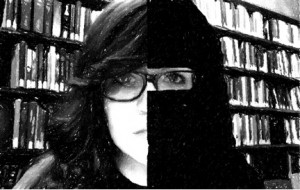Post Five
Identity Through Resistance
(Week 12)

The twentieth century especially was a time of reform in the name of various Islamist ideologies. Much of this reform was political in nature and met with conflict and resistance. However, sub populations of the Muslim population as a whole experienced a transformation of identity in the form of this resistance. For example, contemporary women artists created for themselves a place in the world of “Islamic art” as some traditionally Muslim societies became more westernized and/or truer to Quranic – rather than political – obligations. This theme of identity linked with political resistance is illustrated well in Marjane Satrapi’s graphic novel Persepolis, whichrecounts the experiences of a little girl growing up in Iran during the Islamic revolution. The leader Reza Shah decided to modernize and westernize Iran, much like other traditionally Islamic states were incorporating (or resisting) Western culture. Shortly after this effort began, however, Western influences (Great Britain, in particular) invaded for Iran’s oil supply. The leader’s son, Shah, succeeded him after his father was exiled and then later returned to power until 1979, when he left the country to escape the Islamic revolution. This was a time of changing political discourse surrounding westernization versus traditionally “Islamic” practices, and it erupted in violence, protests, and rebellion, which Satrapi captures in her novel.
This project, which is the merging of two different photographs I took of myself, represents the contrast between the identities Satrapi was pulled between as she grew up in a time of tremendous political and religious upheaval. She first remarks “And then suddenly in 1980… ‘All bilingual schools must be closed down. They are symbols of capitalism.’ […] We found ourselves veiled and separated from our friends” (p. 4), and later describes, “Everywhere in the streets there were demonstrations for and against the veil” (p.5). This reflects her initial naivety and confusion about the revolution, and is reflected in the right portion of the picture in which I am veiled.
As she grows up and begins to decide what she wants, the time comes that universities were officially closed: “Everything needs to be revised to ensure that our children are not lead astray from the true path of Islam. That’s why we’re closing all the universities for a while. Better to have no students at all than to educate future imperialists” said a reporter on television, to which Satrapi reflected, “No more university, and I wanted to study chemistry. I wanted to be like Marie Curie. I wanted to be an educated, liberated woman” (p. 73). This inner desire is represented by the left side of the photo, in which I am unveiled and in my “Westernized” attire, in a library setting. Additionally, the books of shelves in the background represent both that 1) Satrapi searched for information about her identity in the knowledge and propaganda of the time and that 2) the origins of reform, of progress, are more often than not rooted in the dissemination of information, which was the case as reformists throughout the history of Islam argued from a position of Quranic evidence for the equality of the genders rather than relying on politicized word of mouth. The black and white drawing effect I added to the photograph is meant to mirror the graphics in Persepolis and to evoke an eerie, blurred feeling that matches the blurring of identities through changing definitions of modernity and who is “Islamic.”






Recent Comments